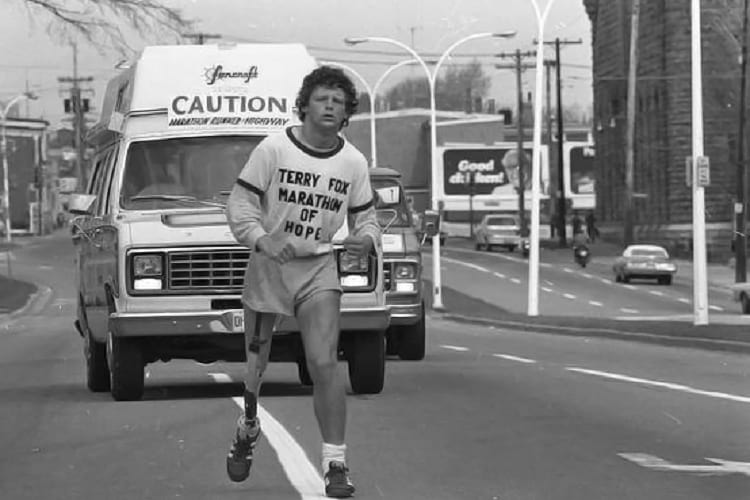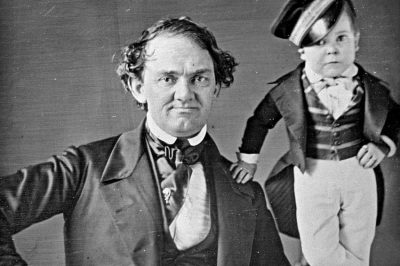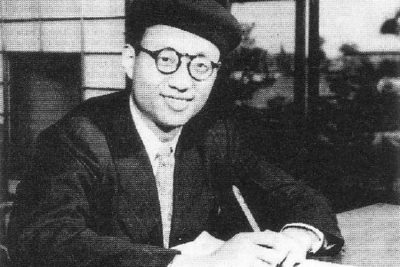The One-legged Runner Who Challenged Cancer: Terry Fox
Share

Terry Fox along North Park St during 1981 Marathon of Hope. (Ross Dunn / Flickr)
Terry Fox was lucky to be born into a loving, caring family. Fortunate enough to have a teacher who inspired him no-end. But a road accident would bring him face to face with bone cancer, and the flip side of life. Could he do something to fight cancer for self, as well as for other patients? Yes, thought the Canadian athlete, Terry Fox. He would run a marathon to collect money for cancer research. And he ran a great distance, taking an artificial leg in his stride. Lost his life, but won against cancer, in a big way.
A versatile outdoor player
Born on July 28, 1958, Terry Stanley Fox was the second sibling among 3 brothers and 2 sisters. The qualities of head and heart he imbibed from his mother Betty, and father Rolly, set him apart from other children of his age group. School’s basketball coach, Bob McGill saw an immense drive in him and felt Terry would do better as a cross country runner than as a basketball player. Terry agreed in letter and spirit. The switch to running was hard in the beginning. But, true to his nature, Terry persisted and impressed his coach. Nevertheless, his love for basketball sustained even as his coach felt he wasn’t good at this game. Coach suggested yet another switch—wrestling. But basketball remained close to Terry’s heart, and his coach finally allowed him into the game. And as a student of class 8th, he became a formidable basketball player.
Excelled in Basketball
Terry was so possessed with the game that he would attend school even when ill. By the time he was in 10th class, Terry had become a key player of his basketball team. His dedicated attempts, irrespective of victory or defeat, were widely appreciated. In the final year of high school, Terry received the Athlete of the year award. Apart from basketball, Terry made his mark in soccer and rugby as well. In academics too, he showed significant improvement. On joining the University, he opted Kinesiology (the study of human movement) as his major subject and aspired to become a coach, a physical education teacher, like Bob. Praising him, Bob McGill said Terry always obeyed his coach. So much so that if the coach asked him to hit head on the wall, Terry would do it without a second thought.
A road accident changed his life
Terry was 18 years and pursuing University education when he met with a road accident in 1976. He escaped, virtually unharmed but with knee-pain that persisted for a long time. Four months later, in 1977, he went for a medical inspection. The report said it was Osteosarcoma, a bone cancer. From the knee, the cancer was spreading to the rest of his body. To check the spread, the leg was amputated at the thigh region. Before the surgical operation took place, his coach was on his bedside. He showed him an article on Dick Traum, an amputee who ran the New York City Marathon. And Terry got his new assignment.
Planned out Marathon of Hope
The surgery and the 16-month long chemotherapy that followed steeled his resolve to run like Dick Traum. Even after the surgery, he continued playing outdoor games – seated on his wheelchair. The plight of fellow cancer patients shook him to the roots. He would run, long and hard, and raise money for the welfare of cancer patients. The run would be called ‘Marathon of Hope’.
Followed his heart to the last breath
Feats that overshoot the limits of physical endurance have mind power behind them. The mind leads, and the body follows. Thigh cells that were supposed to stop growing at a particular biological age, didn’t. They continued to grow. Following surgery, Terry was supposed to lie low and take precautions, but he didn’t. His passion for games, and outdoors, remained undiminished. Cancer and Terry were so much similar, hence, bound to clash.
Resolved to raise money for cancer research
In 1979, Terry wrote to the Canadian Cancer Society asking for funds. He got funds as well as sponsorship for his fundraising run, the Marathon of Hope. On 12th April 1980, he began his marathon from St. John’s, Newfoundland, the easternmost point of Canada. He had reached there in the company of his friend Doug Alward. Start of the run was sober. No fanfare or celebrations that a Herculean effort of this magnitude verily deserved. A determined Terry bathed his leg in the Atlantic Ocean and began the epic run from the east coast of Canada.
Ran marathon for 143 days
Imagine a person running with just one leg, the other leg is artificial. It can’t be a smooth run. It would be a mix of limp and leap. And that’s what defined Terry’s run on the roads of Maritime Provinces. The staccato run of a human frame, braving elements of nature, was a moving experience for the onlookers. Blood oozed on the stub of his thigh and the consequent pain was writ large on runner’s face.

Terry Fox during his 1980 “Marathon of Hope”. (Jeremy Gilbert / Wikimedia Commons)
It was a poignant sight, and people in hordes gathered on roads to cheer and applaud him. Here was a Samaritan, a cancer survivor, running for the welfare of cancer patients. Terry ran 37.5 km (approximately 23.3 miles) every day, for a total of 143 days, end to end.
Ran to the tipping point, and fell to cancer
After covering a distance of 5,372 km (3,338 miles), Terry couldn’t take it any longer. Cancer had raised its head, again. On September 1, 1980, he was forced to stop running. Cancerous cells had invaded his lungs. He was treated, unsuccessfully, at British Columbia. On June 28, 1981, at the age of 22, he succumbed to cancer. But not before bagging coveted awards and honours: The companion of the Order of Canada, Lou Marsh award for outstanding athletic accomplishment and Canadian of the Year. His dream of raising money for cancer research was also realized.
Terry’s spirit survives his death
As they say: End is the beginning. He raised more than 11 million dollars through his Marathon of Hope. The trail he blazed, is here to stay. Terry fox run is held every year in September, in the memory of the prodigal runner. Similar runs are organized in more than 50 countries. The Terry Fox Foundation has raised over 400 million dollars for cancer research. An internet survey in 1999 named Terry Fox as Canada’s greatest hero. In 2004, Terry was declared second greatest (first being Tommy Douglas) Canadian of all time.
He was courage personified
In death, as in life, Terry Fox symbolises courage in adversity. Many buildings and roads in Canada are named after him. At Port Coquitlam, his home town, a city hall is dedicated to his memory. Theatre, Secondary school, Park, and a library in the town bear the name ‘Terry fox’. Port Coquitlam, the town where Terry got his prosthetic leg and learned to use it, is running a nomination campaign to put a picture of Terry on Canadian currency.
The whole of Canada is Terry Fox’s memorial

Terry Fox memorial in Ottawa, Ontario, Canada. (Alex Guibord / Flickr)
A statue of Terry adorns the space near the Prime Minister’s office. A commemorative one-dollar coin of Canada and a mountain have been named in Terry’s honour. Many believe, Terry could be seen on the Canadian currency soon. As per the norm, only the political luminaries find a place on a currency note. Terry may break this rule. As he broke many, so profusely, during his lifetime.
Enjoyed this article? Also, check out “Bobbie the Wonder Dog: Uplifting Story of a Separated Dog that Travelled 2500 Miles to Return Home“.
Fact Analysis:
STSTW Media strives to deliver accurate information through careful research. However, things can go wrong. If you find the above article inaccurate or biased, please let us know at [email protected]













